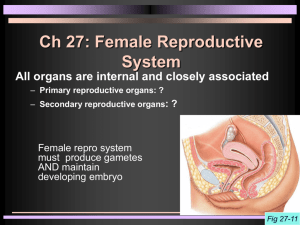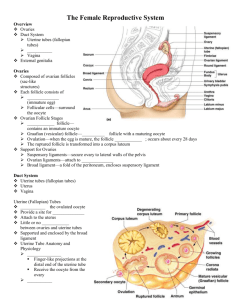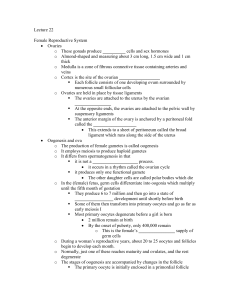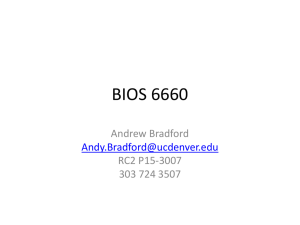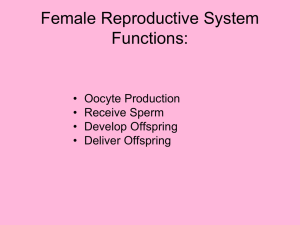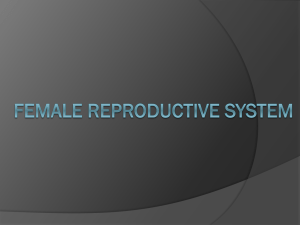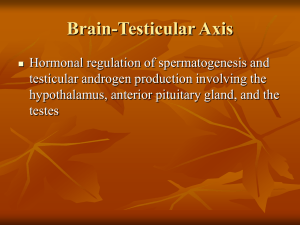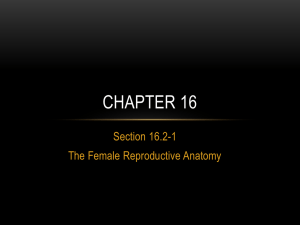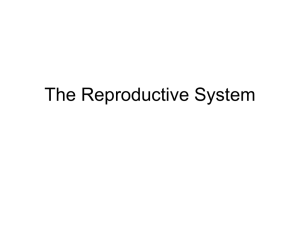Chapter 27 Part B
advertisement
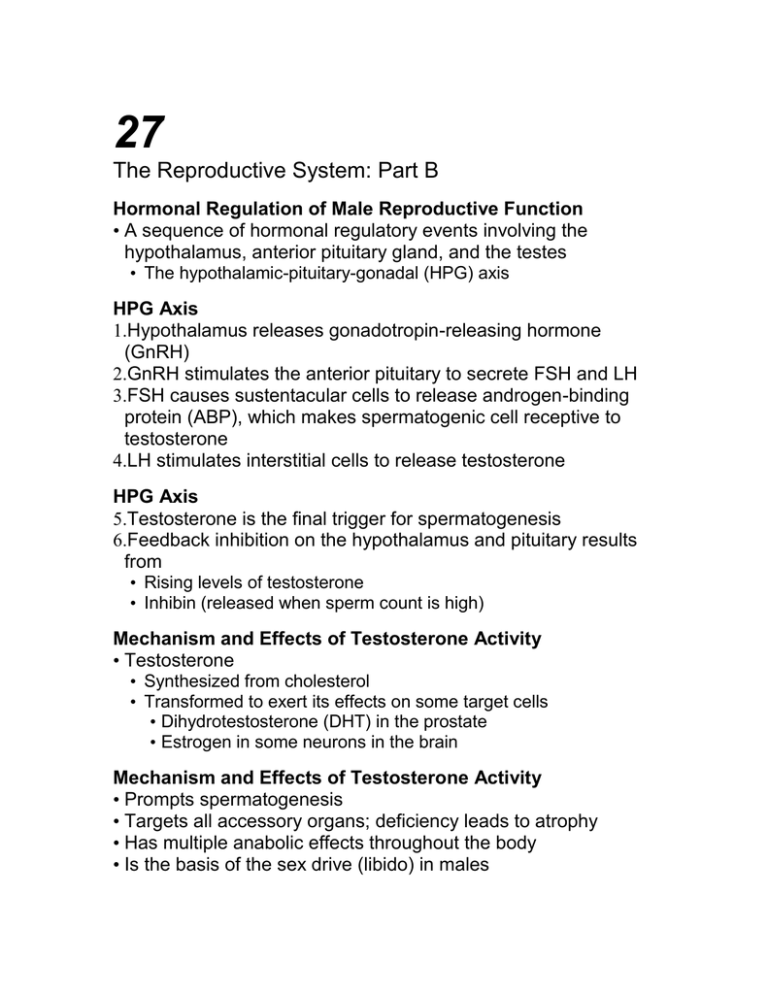
27 The Reproductive System: Part B Hormonal Regulation of Male Reproductive Function • A sequence of hormonal regulatory events involving the hypothalamus, anterior pituitary gland, and the testes • The hypothalamic-pituitary-gonadal (HPG) axis HPG Axis 1.Hypothalamus releases gonadotropin-releasing hormone (GnRH) 2.GnRH stimulates the anterior pituitary to secrete FSH and LH 3.FSH causes sustentacular cells to release androgen-binding protein (ABP), which makes spermatogenic cell receptive to testosterone 4.LH stimulates interstitial cells to release testosterone HPG Axis 5.Testosterone is the final trigger for spermatogenesis 6.Feedback inhibition on the hypothalamus and pituitary results from • Rising levels of testosterone • Inhibin (released when sperm count is high) Mechanism and Effects of Testosterone Activity • Testosterone • Synthesized from cholesterol • Transformed to exert its effects on some target cells • Dihydrotestosterone (DHT) in the prostate • Estrogen in some neurons in the brain Mechanism and Effects of Testosterone Activity • Prompts spermatogenesis • Targets all accessory organs; deficiency leads to atrophy • Has multiple anabolic effects throughout the body • Is the basis of the sex drive (libido) in males Male Secondary Sex Characteristics • Features induced in the nonreproductive organs by male sex hormones (mainly testosterone) • • • • • Appearance of pubic, axillary, and facial hair Enhanced growth of the chest and deepening of the voice Skin thickens and becomes oily Bones grow and increase in density Skeletal muscles increase in size and mass Female Reproductive Anatomy • Ovaries: female gonads • Produce female gametes (ova) • Secrete female sex hormones (estrogen and progesterone) • Accessory ducts include • Uterine tubes • Uterus • Vagina Female Reproductive Anatomy • Internal genitalia • • • • Ovaries Uterine tubes Uterus Vagina • External genitalia • The external sex organs Ovaries • Held in place by several ligaments • Ovarian ligament: anchors ovary medially to the uterus • Suspensory ligament: anchors ovary laterally to the pelvic wall • Mesovarium: suspends the ovary • Broad ligament: supports the uterine tubes, uterus, and vagina; also contains the suspensory ligament and the mesovarium Ovaries • Blood supply: ovarian arteries and the ovarian branch of the uterine artery • Surrounded by a fibrous tunica albuginea • Two poorly defined regions • Cortex: ovarian follicles • Medulla: large blood vessels and nerves Ovaries • Follicle • Immature egg (oocyte) surrounded by • Follicle cells (one cell layer thick) • Granulosa cells (when more than one layer is present) Follicles • Several stages of development • • • • Primordial follicle: squamouslike follicle cells + oocyte Primary follicle: cuboidal or columnar follicle cells + oocyte Secondary follicle: two or more layers of granulosa cells + oocyte Late secondary follicle: contains fluid-filled space between granulosa cells; coalesces to form a central antrum Ovaries • Vesicular (Graafian) follicle • Fluid-filled antrum forms; follicle bulges from ovary surface • Ovulation • Ejection of the oocyte from the ripening follicle • Corpus luteum develops from ruptured follicle after ovulation Female Duct System • Uterine (fallopian) tubes or oviducts • Uterus • Vagina Uterine Tubes • Ampulla • Distal expansion with infundibulum near ovary • Usual site of fertilization • Ciliated fibriae of infundibulum create currents to move oocyte into uterine tube • Isthmus: constricted region where tube joins uterus Uterine Tubes • Oocyte is carried along by peristalsis and ciliary action • Nonciliated cells nourish the oocyte and the sperm • Mesosalpinx: mesentery that supports the uterine tubes Uterus • Body: major portion • Fundus: rounded superior region • Isthmus: narrowed inferior region Uterus • Cervix: narrow neck, or outlet; projects into the vagina • Cervical canal communicates with the • Vagina via the external os • Uterine body via the internal os • Cervical glands secrete mucus that blocks sperm entry except during midcycle Supports of the Uterus • Mesometrium—lateral support: portion of the broad ligament • Lateral cervical (cardinal) ligaments: from the cervix and superior part of the vagina to the walls of the pelvis • Uterosacral ligaments secure uterus to the sacrum • Round ligaments bind to the anterior wall Peritoneal Pouches • Sacs of peritoneum exist around the uterus • Vesicouterine pouch is between bladder and uterus • Rectouterine pouch is between rectum and uterus Uterine Wall • Three layers 1. Perimetrium: serous layer (visceral peritoneum) 2. Myometrium: interlacing layers of smooth muscle 3. Endometrium: mucosal lining Endometrium • Stratum functionalis (functional layer) • Changes in response to ovarian hormone cycles • Is shed during menstruation • Stratum basalis (basal layer) • Forms new functionalis after menstruation • Unresponsive to ovarian hormones Uterine Vascular Supply • Uterine arteries: arise from internal iliacs • Arcuate arteries: in the myometrium • Radial branches in the endometrium branch into • Spiral arteries stratum functionalis • Straight arteries stratum basalis • Spasms of spiral arteries leads to shedding of stratum functionalis Vagina • Birth canal and organ of copulation • Extends between the bladder and the rectum from the cervix to the exterior • Urethra embedded in the anterior wall Vagina • Layers of wall 1. Fibroelastic adventitia 2. Smooth muscle muscularis 3. Stratified squamous mucosa with rugae • Mucosa near the vaginal orifice forms an incomplete partition called the hymen • Vaginal fornix: upper end of the vagina surrounding the cervix External Genitalia (Vulva or Pudendum) • Mons pubis: fatty area overlying pubic symphysis • Labia majora: hair-covered, fatty skin folds • Labia minora: skin folds lying within labia majora • Vestibule: recess between labia minora External Genitalia • Greater vestibular glands • Homologous to the bulbourethral glands • Release mucus into the vestibule for lubrication External Genitalia • Clitoris • Erectile tissue hooded by a prepuce • Glans clitoris: exposed portion • Perineum • Diamond-shaped region between the pubic arch and coccyx • Bordered by the ischial tuberosities laterally Mammary Glands • Modified sweat glands consisting of 15–25 lobes • Areola: pigmented skin surrounding the nipple • Suspensory ligaments: attach the breast to underlying muscle • Lobules within lobes contain glandular alveoli that produce milk Mammary Glands • Milk lactiferous ducts lactiferous sinuses open to the outside at the nipple Breast Cancer • Usually arises from the epithelial cells of small ducts • Risk factors include: • Early onset of menstruation and late menopause • No pregnancies or first pregnancy late in life • Family history of breast cancer • 10% are due to hereditary defects, including mutations to the genes BRCA1 and BRCA2 Breast Cancer: Detection and Treatment • 70% of women with breast cancer have no known risk factors • Early detection via self-examination and mammography • Treatment depends upon the characteristics of the lesion: • Radiation, chemotherapy, and surgery followed by irradiation and chemotherapy Oogenesis • Production of female gametes • Begins in the fetal period • Oogonia (2n ovarian stem cells) multiply by mitosis and store nutrients • Primary oocytes develop in primordial follicles • Primary oocytes begin meiosis but stall in prophase I Oogenesis • Each month after puberty, a few primary oocytes are activated • One is selected each month to resume meiosis I • Result is two haploid cells • Secondary oocyte • First polar body Oogenesis • The secondary oocyte arrests in metaphase II and is ovulated • If penetrated by sperm the second oocyte completes meiosis II, yielding • Ovum (the functional gamete) • Second polar body Ovarian Cycle • Monthly series of events associated with the maturation of an egg • Two consecutive phases (in a 28-day cycle) • Follicular phase: period of follicle growth (days 1–14) • Ovulation occurs midcycle • Luteal phase: period of corpus luteum activity (days 14–28) Follicular Phase • Primordial follicle becomes primary follicle 1. The primordial follicle is activated • Squamouslike cells become cuboidal 2. Follicle enlarges to become a primary (1) follicle Follicular Phase 3. Primary follicle becomes a secondary follicle • Stratified epithelium (granulosa cells) forms around oocyte • Granulosa cells and oocyte guide one another’s development Follicular Phase 4. Secondary follicle becomes a late secondary follicle • Connective tissue (theca folliculi) and granulosa cells cooperate to produce estrogens • Zona pellucida forms around the oocyte • Fluid begins to accumulate Follicular Phase 5. Late secondary follicle becomes a vesicular follicle • Antrum forms and expands to isolate the oocyte with its corona radiata on a stalk • Vesicular follicle bulges from the external surface of the ovary • The primary oocyte completes meiosis I Ovulation • Ovary wall ruptures and expels the secondary oocyte with its corona radiata • Mittelschmerz: twinge of pain sometimes felt at ovulation • 1–2% of ovulations release more than one secondary oocyte, which, if fertilized, results in fraternal twins Luteal Phase • Ruptured follicle collapses • Granulosa cells and internal thecal cells form corpus luteum • Corpus luteum secretes progesterone and estrogen Luteal Phase • If no pregnancy, the corpus luteum degenerates into a corpus albicans in 10 days • If pregnancy occurs, corpus luteum produces hormones until the placenta takes over at about 3 months Establishing the Ovarian Cycle • During childhood, ovaries grow and secrete small amounts of estrogens that inhibit the hypothalamic release of GnRH • As puberty nears, GnRH is released; FSH and LH are released by the pituitary, and act on the ovaries • These events continue until an adult cyclic pattern is achieved and menarche occurs
